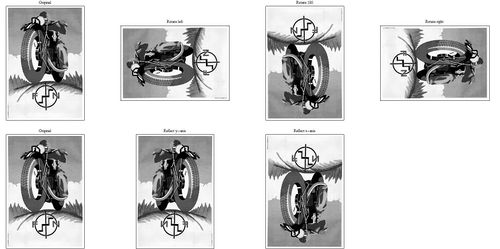Assignments
From Classes
(Difference between revisions)
HelmutKnaust (Talk | contribs) |
HelmutKnaust (Talk | contribs) |
||
| Line 4: | Line 4: | ||
# Find the vertical edges of a grayscale image (of your choice). Hint: For horizontal edges this is done in Notebook 031. | # Find the vertical edges of a grayscale image (of your choice). Hint: For horizontal edges this is done in Notebook 031. | ||
# Pick a small grayscale image (your choice) and use matrix transposition and multiplication with suitable matrices to produce the following six images: [[image:FN.jpg|500px]] | # Pick a small grayscale image (your choice) and use matrix transposition and multiplication with suitable matrices to produce the following six images: [[image:FN.jpg|500px]] | ||
| + | # In Notebook 032 you have seen how to convert a color image to its YCbCr components. Recreate the original color image from its Y-, Cb- and Cr- components. (Check your result by computing the Peak Signal to Noise Ratio to the original image. Note that when computing the luminance/chrominance components, we round to the nearest integer. ) | ||
# Problem 3.8 | # Problem 3.8 | ||
# Problem 3.16 | # Problem 3.16 | ||
| + | # Problem 3.23 | ||
| + | # Problem 3.26 | ||
| + | # Problem 3.35 | ||
| + | # Problem 3.37 | ||
| + | # Problem 3.50 | ||
| + | # Problem 3.42 | ||
Revision as of 11:43, 12 June 2013
- Let \(A=\begin{pmatrix}1&2&3\\4&5&6\\7&8&10\end{pmatrix}\). Find a matrix X such that \(X\cdot A=\begin{pmatrix}7&8&10\\4&5&6\\1&2&3\end{pmatrix}\). What do you get if you compute \(A\cdot X\)?
- Find a 4x4 orthogonal matrix with at least 5 non-zero entries.
- Can you find a 3x3 orthogonal matrix with no zeroes? Notebook
- Find the vertical edges of a grayscale image (of your choice). Hint: For horizontal edges this is done in Notebook 031.
- Pick a small grayscale image (your choice) and use matrix transposition and multiplication with suitable matrices to produce the following six images:

- In Notebook 032 you have seen how to convert a color image to its YCbCr components. Recreate the original color image from its Y-, Cb- and Cr- components. (Check your result by computing the Peak Signal to Noise Ratio to the original image. Note that when computing the luminance/chrominance components, we round to the nearest integer. )
- Problem 3.8
- Problem 3.16
- Problem 3.23
- Problem 3.26
- Problem 3.35
- Problem 3.37
- Problem 3.50
- Problem 3.42